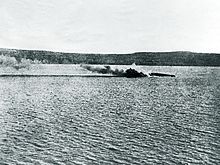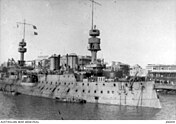Bouvet (ship, 1898)
|
|
|
|---|---|
 The bouvet |
|
| Overview | |
| Type | Ship of the line |
| Shipyard |
State shipyard, Lorient |
| Keel laying | January 16, 1893 |
| Launch | April 27, 1896 |
| Namesake | François Joseph Bouvet |
| Commissioning | July 15, 1898 |
| home port | Toulon |
| Whereabouts | sunk on March 18, 1915 after being hit by a mine in the Dardanelles |
| Technical specifications | |
| displacement |
12,200 t |
| length |
122.6 m over everything, |
| width |
21.39 m |
| Draft |
8.38 m |
| crew |
666-710 men |
| drive |
24 Belleville boilers, |
| speed |
18 kn |
| Range |
2500 nm at 10 kn |
| Armament |
• 2 × 305 mm L / 40 cannon M.93 |
| Armored belt |
400 mm |
| Armored deck |
90 mm |
The Bouvet was a ship of the line of the French Navy that was launched in 1896 and sank in the Dardanelles after a mine hit during World War I in 1915 . 660 sailors found their deaths on it.
Building history
The Bouvet was named after the Bouvet de Lozier family who produced some famous naval officers. The most famous of them was the Admiral François Joseph Bouvet (1753-1832), naval commander of the unsuccessful campaign in Ireland in 1796/1797.
The Bouvet formed a class with the very similar ships of the line Charles Martel , Jauréguiberry , Carnot and Masséna . Bouvet and her near-sister ships were a step backwards in French battleship development. They had a relatively small displacement, a high trunk with a very pronounced Schildkröt back (so-called tumble home design) and many unprotected superstructures.
The four heavy guns were set up in small individual turrets, with the two 305 mm L / 40 guns serving as bow and stern guns and the two 274 mm L / 45 guns next to the rear funnel in side swallow nests above the Torso curvature stood. The eight 138 mm L / 45 cannons were also set up in turrets. The internal subdivision was insufficient.
Old-fashioned in shape and artillery deployment, the Bouvet , like the Masséna , had a modern 3-shaft drive with effective Belleville boilers, and its armor above the waterline was made of hardened Harvey steel , making it one of the best-armored ships of its time made.
On August 8, 1898, the Bouvet began its service in the Mediterranean squadron. From 1908 she belonged to the 3rd squadron. When war broke out, she secured the transports across the Mediterranean and was seconded to the Dardanelles in December 1914. From February 25, 1915, she and other units of the Allied fleet fired at Turkish positions at the entrance to the strait.
Loss in the Dardanelles
The Bouvet was part of the French squadron for the breakthrough through the Dardanelles . On March 18, 1915, she took part with three other French ships under the British commander, Rear Admiral John de Robeck , in the great attempt to force the passage through the strait or at least to defeat the Turkish forts. The British had recognized that there were at least five minefields at the narrow point of the Dardanelles between Canakkale and Kilid Bahr and wanted to disable the securing fortifications so that the mine barriers could be cleared at night. The French ships formed the second line of the attack squadron.
The end of the bouvet
The bombardment began around 11:00 a.m. Shortly after noon, the French ships were ordered forward to take out the forts on the narrows. The guns of the Turkish fortresses hit the Suffren and Gaulois , both of which were severely damaged. The Bouvet also received eight hits from the Turkish artillery and its forward turret failed. When the defensive fire of the Turks subsided, de Robeck decided around 1:25 p.m. to replace the French ships with the second line of British ships. To retreat, the Bouvet turned to starboard into Erenköy Bay, which contained a number of previously undiscovered mines . Below the 274 mm starboard turret, a mine exploded at 13:54, and therefore a magazine there . In the middle of the bouvet there were also two towers of the middle artillery and the lateral underwater torpedo tube. The ship of the line suffered a very strong water ingress in the area of the large, undivided engine room, which took up a third of the ship's length. The ship immediately overturned because there was a lack of internal partitioning and the back of the whale hull arching inwards again (as in other ships constructed by Huin ) led to increasing instability when listing. The Bouvet capsized after a short time and sank within two minutes at 40 ° 1 ' N , 26 ° 17' O . 648 men died in the sinking, including the commander Rageot de la Touche, who refused to leave the bridge. The Suffren's admiral dinghy was able to save 75 men (47 according to other sources), including five officers.
More losses
The British leadership did not recognize the cause of this loss, but suspected a gun or torpedo hit and continued the attack on the narrow passage. When the battle cruiser HMS Inflexible, which had been hit several times by the artillery, was withdrawn around 4 p.m., it was hit by a mine near the place where the Bouvet sank, killing over 30 sailors and tearing a large hole in the foredeck on starboard.
Shortly afterwards, at 16:16, the HMS Irresistible also hit a mine and was badly damaged. Almost the entire crew, except for the captain and some volunteers, was picked up by HMS Wear and taken to HMS Queen Elizabeth . An attempt by HMS Ocean to tow and rescue the Irresistible , which was slowly drifting towards the coast , failed because of the strong list of the ship and the heavy Turkish artillery fire.
The Ocean rescued the remaining crew members, but ran into a mine at 6:05 p.m. and received a direct artillery hit shortly afterwards. Their crew and the men rescued by the Irresistible were brought to safety. The two abandoned battleships sank after 8:00 p.m. on the evening of March 18. Late skilful by the Royal Navy in the Strait destroyer , which was to torpedo them, so they did not fall into the hands of the enemy, they did not find more.
The heavily damaged battle cruiser Inflexible was able to continue slowly after the mine hit and was only set aground in front of Tenedos so as not to sink. Temporarily sealed on site, the Inflexible set off on April 6th, accompanied by HMS Canopus and HMS Talbot , for repairs to Malta . The damaged French liners Suffren and Gaulois were also able to withdraw. The latter had to sit aground due to strong water ingress near Rabbit Island ( Tavşan ), north of Tenedos, in order not to sink. After an emergency repair, she ran with Suffren via Malta to Toulon on March 25 for repairs.
On the night of March 8, the small Turkish mine- layer Nusret (Germania, 1911, 365 ts) laid 26 mines unobserved in an area in which the Allied ships had maneuvered during the previous bombardments. The sinking of the Bouvet and the two old British ships of the line led to the abandonment of the plan to get through the strait directly to Constantinople , since although the old ships of the line were dispensable, a mine-free route and the elimination of the Turkish artillery was no longer expected, and he also led to the decision to take the Gallipoli peninsula beforehand .
| Fate of the ships of the line in the 1890 construction program | |||||
|---|---|---|---|---|---|
| Surname | Shipyard | start of building | Launch | in service | further fate |
| Charles Martel | Arsenal Brest | 08.1891 | 08/29/1893 | 01/10/1896 | 1912 reserve, from 1914 barge in Brest. |
| Jauréguiberry | La Seyne | 11.1891 | 10/27/1893 | 02/16/1897 | 1914 Securing of troop transports North Africa-France, 1915 Dardanelles / Gallipolli, 1916 guard ship Port Said, 1919 to 1932 accommodation ship Toulon |
| Carnot | Toulon | 07.1891 | 07/12/1894 | 06/25/1897 | 1913 reserve, from 1914 barge in Brest |
| Masséna | St. Nazaire | 09.1892 | 07.1895 | 06.1898 | Operation off Gallipoli, aground after being hit by a mine near Cape Helles on November 10, 1915. Served as a breakwater when the Allies withdrew in January 1916. |
Web links
- Bouvet website with lots of old photos
- www.battleships-cruisers.co.uk - Bouvet
- Cuirasse Bouvet
- Plans and documents for the Bouvet des Service Historique de la Défense (French)
Footnotes
- ^ A b Stanley Sandler, Spencer C. Tucker: Battleships: an illustrated history of their impact 2004, ISBN 1-85109-410-5 , p. 81.
- ↑ Description of the French 305 mm L / 40 guns
- ↑ Description of the French 274 mm L / 45 guns
- ↑ Description of the French 138 mm L / 45 guns
- ↑ Map of the attack
- ↑ Report on one of the victims ( Memento of the original from September 27, 2007 in the Internet Archive ) Info: The archive link was inserted automatically and has not yet been checked. Please check the original and archive link according to the instructions and then remove this notice. (French)
- ↑ liner Suffren (Engl.)
- ↑ Information on the Nusret
- ↑ http://www.naval-history.net/WW1NavyFrench.htm
- ^ Website on the Masséna with many photos




